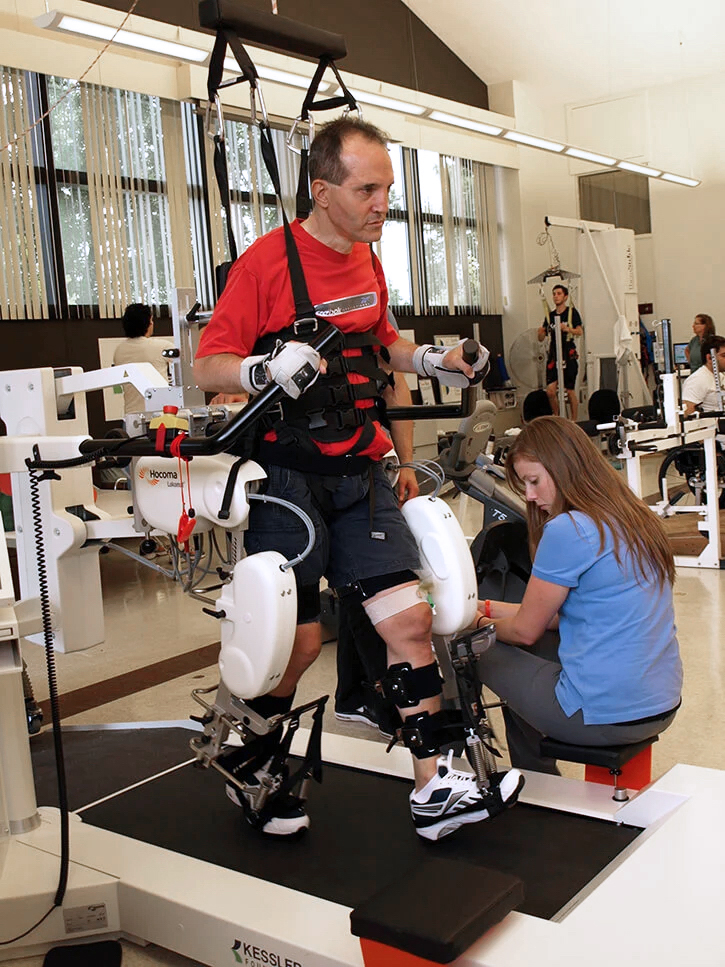Advanced Robotics and Rehabilitation Technologies
How Advanced Rehabilitation Technologies Help Patient Recovery

Technology has been woven into nearly every aspect of our lives, including medical rehabilitation. Evidence-based research* shows patients are making major strides, faster, when advanced robotics are integrated into rehabilitation treatment programs. That’s especially true for people recovering from a stroke, spinal cord or brain injury.
Robotic technology allows patients to perform a much higher number of specific repetitive movements during a treatment session as compared to a conventional session. More repetitive movement is accomplished through the equipment’s sensors that monitor, assist and provide precise support for a patient’s position and movements.
Concentrated repetition in rehabilitation treatment plays an important role in a process called neuroplasticity, which is the brain’s ability to reorganize by creating new neural pathways. Simply put, it is this ability to reconnect the flow of communication from brain to body that helps patients relearn how to walk and perform everyday life activities. By increasing the intensity of repetitions, robotics technology, blended with the expert skills of a licensed therapist, can enhance a patient’s recovery process.
Select Medical has utilized rehabilitation technologies for several years. Through an Advanced Technology Committee, the post-acute care provider continuously scouts for and evaluates new rehabilitation technologies that yield solid, evidence-based outcomes. That’s why it has expanded its treatment program to include advanced robotics in 26 of its inpatient rehabilitation hospital therapy gyms across the U.S.
In addition to the clinical benefits derived from these technologies, many of the devices have other advantages as well. Patients are highly engaged and motivated to accomplish goals based on integrated video games or biofeedback. This type of experience provides a challenge and reward model that guides the therapy experience, according to therapists. The equipment is also fully customizable to support the therapists’ treatment plans and the abilities of the patient at every stage of recovery.

Advanced Rehabilitation Technologies in Our Hospital Therapy Gyms**
- Exoskeleton — A wearable robotic suit designed to help patients learn to stand and walk again.
- ArmeoSpring — A robotic arm for the upper extremities — shoulder to fingers — that helps retrain self-initiated movement.
- Lokomat — A fixed, lower body exoskeleton with a treadmill that uses robotics along with a body weight support harness to retrain patients in how to walk.
- Andago — A robotic device that supports a patient’s body weight through an over the head harness system. It is used to help patients relearn to walk.
- Erigo — A therapy treatment table that can tilt a patient from a lying to a standing position. It’s combined with a robotic stepper device that promotes leg movements. The Erigo also uses Functional Electrical Stimulation (FES) which mimics electrical brain signals, helping reactivate impaired muscles.
- Bioness H200 — A wireless hand rehabilitation system that uses FES to help patients with weak or paralyzed limbs regain the skills needed for reaching, grasping, opening and closing the hand. This technology uses Functional Electrical Stimulation (FES) which mimics electrical brain signals, helping reactivate impaired muscles.
- Bioness L300 Go — A wireless thigh and foot drop system that uses FES to stimulate specific muscles to help patients walk more naturally with improved speed and balance.
- Bioness Integrated Therapy System (BITS) — A large touch screen digital display with programmed exercises to improve physical, visual, auditory and cognitive abilities of individuals with deficits in these areas.
- RT300 Electrical Stimulation Bike — A stationary bike that uses FES to help patients with weak or paralyzed muscles perform peddling movements with their arms and legs.
- LiteGait — A mobile system offering bodyweight support that is used for gait and balance training. It bridges the gap between treadmill gait training and free over ground walking.
*Robot-Assisted Training of Arm and Hand Movement Shows Functional Improvements for Incomplete Cervical Spinal Cord Injury, American Journal of Physical Medicine & Rehabilitation, October 2017
*Effectiveness of robotic assisted rehabilitation for mobility and functional ability in adult stroke patients: a systematic review. The JBI Database of Systematic Reviews and Implementation Reports, January 2017
*Robotics in Lower-Limb Rehabilitation after Stroke Behavioral Neurology, June 2017
**Specific equipment varies by hospital
How can we help you?
We will work closely with you and your family, physician and/or the referring hospital to ensure a smooth transition.
